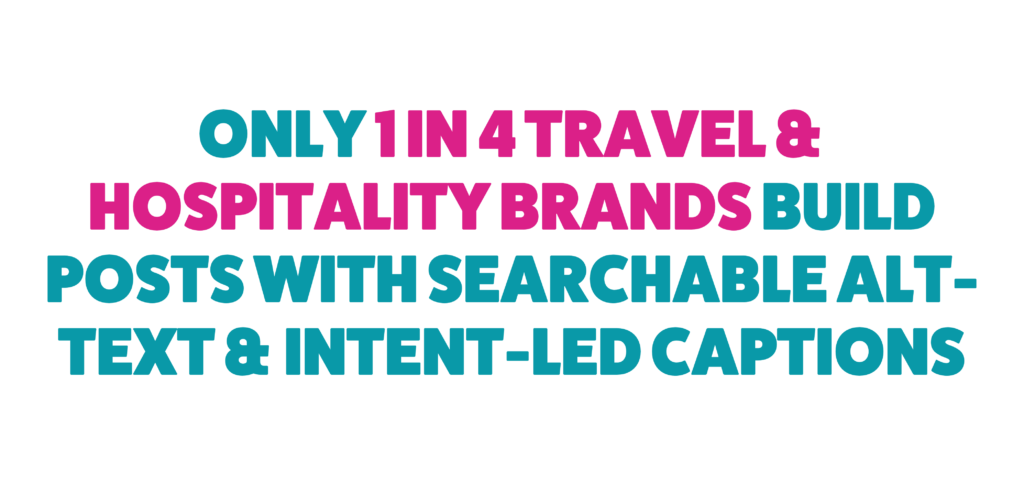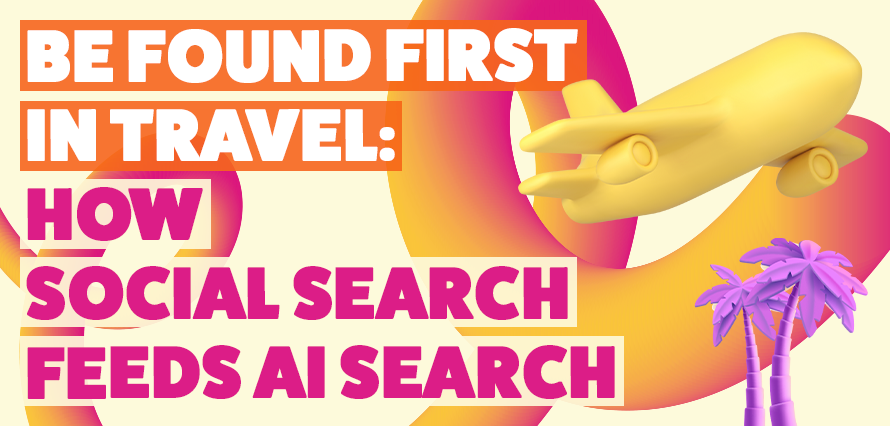August 18, 2025
Travel discovery has moved. People still “Google,” but the real decisions are being shaped by what they see and ask in social, and then resolved by AI assistants that summarise it all for them. It’s the era of social search and Ai discoverability. If your brand isn’t showing up clearly in social and in machine-readable form, you’re invisible at the very moment intent forms.
In late 2024 the share of travel queries triggering Google’s AI Overview jumped from 1% to 29%. Organic clicks on “where to go” articles almost halved. At the same time 37% of leisure travellers tried ChatGPT itineraries, and one major OTA now sees 12% of bookings arrive from TikTok links. Yet fewer than 1 in 4 travel brands optimise captions, alt-text and file names for social or AI. The gap is your shortcut.

What “social search” really means in travel now
Travellers don’t follow a neat line from keyword to click to booking. They bounce between Instagram Reels, TikTok comments, YouTube Shorts, Reddit threads and WhatsApp chats, then ask an AI to tidy up the options. As we said on the Linked in live session on social search, “If we wait for travellers to reach our website, we’ve already ceded the sale to the platform that answers them first.”
That answer can be yours if your content looks like the questions people actually ask, and if it’s labelled so both humans and models can recognise authority quickly. In the webinar I put it plainly: “Plain always beats poetic. Named experts build trust.” A clip titled “Head Concierge Maria — best three tapas bars near our hotel” tells algorithms you’re credible, and it tells guests a real person stands behind the advice. “Write every answer as neat, 50 word blocks” so the same tip works in a Reel, a blog paragraph or an AI itinerary.
Seeing “agent mode” in action is a bit of a watershed. As James at Remarkable puts it, “agent mode is now here.” You don’t just type a destination and skim links; you “ask it to plan you a holiday and to go and browse around the internet for you.”
In his prompt he gives it what he’d “give a travel agent,” from dates to kids to “near a water park,” and the AI goes off to work. It browses different websites, checks reviews and social proof, then returns curated options at three price points… a top, middle and bottom. The kicker is end-to-end action: “I ask it to add the cheapest option to my basket, ready for me to check out.” As James says, “the ability to do that right the way to the point where I can transact is a monumental shift,” and these agents will only get better as they “learn users’ wants and needs,” turning planning into a single, conversational flow.
Why visibility shifted to social plus AI
- AI Overviews appear for roughly a third of travel searches, a 700% jump in exposure in one month during 2024. Several brands report 30 to 40% traffic drops when AI solves the query on the results page. You have to surface content that AI can cite up-front.
- Social is feeding those answers. AI systems lift language from YouTube captions, LinkedIn PDFs and Reel text, not just metadata. That means your on-screen words, alt text and file names matter more than ever.
- Search is more conversational. Average prompts are longer and multi-part. Content that answers the current question and anticipates the next is rewarded.
Three quick wins you can run this week
1. Social SEO hygiene
Update ten hero posts across LinkedIn, YouTube, TikTok or your blog. Use descriptive, destination-led titles, on-screen text or transcripts, and the exact phrases real guests type. Finish with a concise, keyword-rich summary.
2. AI-readable expertise
Package human authority so models can see it. Quote the chef, the captain, the concierge. Use plain questions guests actually ask — visas, baggage rules, late check-out. Publish in 40–60 word blocks so assistants can lift answers verbatim.
3. Write for travellers and robots
Swap copywriter flair for traveller language. Rename files before upload, “barcelona-48-hour-itinerary.png” beats “IMG_4321.png.” Add clear, descriptive alt text. Include a 50-word summary wherever possible.
Common traps to avoid
- Polish over clarity
Aerials look great, but guests still search for “pool depth,” “late check-out fee” and “parking.” Put the practicals in text overlays or pinned comments so search and AI can see them. - Hashtag stuffing
Reels and TikToks rank by spoken words, on-screen text and the first lines of your caption. One location and one theme are enough. Use the language a traveller would type. - Invisible authority
Generic brand posts don’t build trust. Name your experts and state their role in the asset title, caption and alt text. It signals credibility to people and machines.
What you’ll take from the webinar
- The new patterns of discovery in travel, with data across AI Overviews, zero-click behaviour and social-first itinerary planning.
- Practical demonstrations of agent-mode planning and how content structure affects whether you show up in the answer.
- A simple field guide that your team can adopt now. It’s the same framework we used on the session.
Watch and download
Watch the full session on LinkedIn
https://www.linkedin.com/events/7350565393972748288/
Get the Social Search and AI Readiness Framework for Travel
https://immediatefuture.co.uk/resource/social-search-ai-framework-travel/
If you want a working session to apply the framework to your content library, say the word and we’ll jump in.
